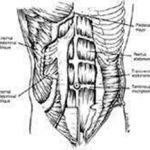Maximize Your Core Training

- posted: Mar. 28, 2017
The core is always being redefined in the fitness industry and probably for good reason. There are a number of components involved: diaphragm, pelvic floor, rectus abdominis, transverse abdominis (TVA), spinal erectors, multifidus, quadratus lumborum (QL) and internal/external obliques. This is not an all-encompassing list, but it will be a good starting point.
All these components are responsible for different movements/stabilization, which is why it’s important to train your core in different planes of movement. Unfortunately, most of the time we focus on just one muscle, the rectus abdominis.
Typical core workout
For the average gym member, a core workout will consist of 500 sit-ups, 5 minutes of biking abs and a finisher of crunches until they can’t sit up and their neck fatigues. Now this might be exaggerated a little. However, I’ve had this routine, or ones very similar, explained to me on multiple occasions. I don’t fault athletes for using these exercises, but I do try to educate the importance of other areas and methods—I’ll get to those shortly.
Problems with those exercises
If you’ve ever heard of Dr. Stewart McGill, you are well ahead of the curve. He’s the leading expert in low-back research and has been for years. He believes that a proper sit-up can be done, but it’s incredibly difficult and doesn’t look anything like this:
Here are my biggest concerns with typical sit-ups. Due to our technology-based world, we spend a lot of time at a computer and sitting in the car, which hasn’t been great for our posture. Then we go to the gym, bench press and do sit-ups, which all compound to create more bad posture, poor breathing patterns and a dysfunctional core. But you thought core training was good?
Core training is extremely beneficial, though too many crunches and sit-ups simply aren’t. Doing sit-ups creates specific postural movement patterns. Your rectus abdominis pulls your rib cage down, promoting a kyphotic position (hunched over, see picture above). Additionally, your scapula (shoulder blades) abduct and anteriorly tilt. These two movement patterns alone create a very disadvantageous postural position and many potential tissue problems down the road.
For a simple example, when your scapula abducts and tilts anterior (hunched over), you decrease your shoulders subacromial space, resulting in an increase in shoulder impingement and potentially pain. So, if you have shoulder issues, sit-ups are out. If you’re sitting at your computer and have been for hours, sit-ups are out.
This is just my personal opinion when it comes to excluding sit-ups for my clients training programs. I think there are plenty of other core exercises that come closer to fulfilling the function of the core. Just doing sit-ups neglects the core’s function to: assist with breathing, resist spinal deformation and transfer power between your arms and legs. Instead of just thinking about forward flexion (sit-ups) to train the core, use these categories to help iron out your core training: Anterior, Lateral, Rotary and Posterior. We will focus on the first three because most of your posterior training will come from lifting exercises (deadlifts, RDL, good-mornings, etc.).
Anterior Core
Ab Rollout / Body Saw / Miyagis
Lateral Core
Offset Farmers Walk / Waiter Walk / Lateral Pallof
Rotary Core
Pallof Press / Half-Kneeling Pallof Press / Tall-Kneeling Pallof Press
All of the exercises I’ve shown require that you stabilize the spine and resist any spinal motion. I don’t think you should remove all spinal-movement-based core exercises. However, you have to earn the right to train with motion. It’s been documented that repetitive spinal flexion can lead to disc problems. In fact, forward flexion may be the worst possible motion for your spine. McGill’s recent study examined the role of rotation on disc herniations and compared them to repetitive flexion. In short, they found that axial torque/twist alone was unable to initiate a disc herniation, which is good for back health. However, though there were other potentially negative effects on the spine, forward flexion represented the most disc displacement.
Core training is more than just working on your six-pack. Remember to train the other categories of core—you’ll have a healthier and happier body.
Written by Paul Collins – BS, CSCS
Paul Collins is the owner and founder of Peak Condition, a training facility helping clients and athletes from all walks of life achieve their physique and sports performance goals. He received his Bachelor’s Degree in Exercise Science from Linfield College. As a student athlete, he conducted independent research for sports performance through deep-water running, which aided in its prescription for recovering or rehabbing athletes. This fascination led to becoming a Certified Strength and Conditioning Specialist (CSCS) through the National Strength and Conditioning Association. It is Paul’s personal and professional goal to be the catalyst for his clients to achieve high levels of physical fitness and sports performance.

- posted: Mar. 28, 2017
The core is always being redefined in the fitness industry and probably for good reason. There are a number of components involved: diaphragm, pelvic floor, rectus abdominis, transverse abdominis (TVA), spinal erectors, multifidus, quadratus lumborum (QL) and internal/external obliques. This is not an all-encompassing list, but it will be a good starting point.
All these components are responsible for different movements/stabilization, which is why it’s important to train your core in different planes of movement. Unfortunately, most of the time we focus on just one muscle, the rectus abdominis.
Typical core workout
For the average gym member, a core workout will consist of 500 sit-ups, 5 minutes of biking abs and a finisher of crunches until they can’t sit up and their neck fatigues. Now this might be exaggerated a little. However, I’ve had this routine, or ones very similar, explained to me on multiple occasions. I don’t fault athletes for using these exercises, but I do try to educate the importance of other areas and methods—I’ll get to those shortly.
Problems with those exercises
If you’ve ever heard of Dr. Stewart McGill, you are well ahead of the curve. He’s the leading expert in low-back research and has been for years. He believes that a proper sit-up can be done, but it’s incredibly difficult and doesn’t look anything like this:
Here are my biggest concerns with typical sit-ups. Due to our technology-based world, we spend a lot of time at a computer and sitting in the car, which hasn’t been great for our posture. Then we go to the gym, bench press and do sit-ups, which all compound to create more bad posture, poor breathing patterns and a dysfunctional core. But you thought core training was good?
Core training is extremely beneficial, though too many crunches and sit-ups simply aren’t. Doing sit-ups creates specific postural movement patterns. Your rectus abdominis pulls your rib cage down, promoting a kyphotic position (hunched over, see picture above). Additionally, your scapula (shoulder blades) abduct and anteriorly tilt. These two movement patterns alone create a very disadvantageous postural position and many potential tissue problems down the road.
For a simple example, when your scapula abducts and tilts anterior (hunched over), you decrease your shoulders subacromial space, resulting in an increase in shoulder impingement and potentially pain. So, if you have shoulder issues, sit-ups are out. If you’re sitting at your computer and have been for hours, sit-ups are out.
This is just my personal opinion when it comes to excluding sit-ups for my clients training programs. I think there are plenty of other core exercises that come closer to fulfilling the function of the core. Just doing sit-ups neglects the core’s function to: assist with breathing, resist spinal deformation and transfer power between your arms and legs. Instead of just thinking about forward flexion (sit-ups) to train the core, use these categories to help iron out your core training: Anterior, Lateral, Rotary and Posterior. We will focus on the first three because most of your posterior training will come from lifting exercises (deadlifts, RDL, good-mornings, etc.).
Anterior Core
Ab Rollout / Body Saw / Miyagis
Lateral Core
Offset Farmers Walk / Waiter Walk / Lateral Pallof
Rotary Core
Pallof Press / Half-Kneeling Pallof Press / Tall-Kneeling Pallof Press
All of the exercises I’ve shown require that you stabilize the spine and resist any spinal motion. I don’t think you should remove all spinal-movement-based core exercises. However, you have to earn the right to train with motion. It’s been documented that repetitive spinal flexion can lead to disc problems. In fact, forward flexion may be the worst possible motion for your spine. McGill’s recent study examined the role of rotation on disc herniations and compared them to repetitive flexion. In short, they found that axial torque/twist alone was unable to initiate a disc herniation, which is good for back health. However, though there were other potentially negative effects on the spine, forward flexion represented the most disc displacement.
Core training is more than just working on your six-pack. Remember to train the other categories of core—you’ll have a healthier and happier body.
Written by Paul Collins – BS, CSCS
Paul Collins is the owner and founder of Peak Condition, a training facility helping clients and athletes from all walks of life achieve their physique and sports performance goals. He received his Bachelor’s Degree in Exercise Science from Linfield College. As a student athlete, he conducted independent research for sports performance through deep-water running, which aided in its prescription for recovering or rehabbing athletes. This fascination led to becoming a Certified Strength and Conditioning Specialist (CSCS) through the National Strength and Conditioning Association. It is Paul’s personal and professional goal to be the catalyst for his clients to achieve high levels of physical fitness and sports performance.
Office Hours
Monday
9:00 am - 6:00 pm
Tuesday
Closed
Wednesday
9:00 am - 6:00 pm
Thursday
2:00 pm - 6:00 pm
Friday
9:00 am - 6:00 pm
Saturday
Closed
Sunday
Closed
